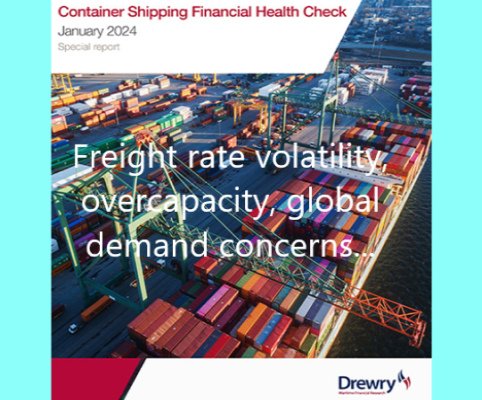Drewry is a leading provider of research and consulting services to the maritime and shipping industry, offering insights into ports, shipping lines and containers. They have released their Container Shipping Financial Health Check 2024. In this report they assess the current state of each of the key players in the sector. The keywords of the document are ‘Freight rate volatility, overcapacity, global demand concerns.’
Drewry notes that container shipping companies reported dismal results in 2023, which was in line with their expectations. They point out that shipping companies are increasingly rerouting vessels around the Cape of Good Hope due to security threats in the Red Sea. This alternative route boosted the charter market, especially for smaller and mid-sized ships, as carriers scramble to maintain service schedules by chartering more vessels.
While the Red Sea crisis supports container shipping companies’ profitability in the near term, it does little to address looming concerns of overcapacity.
Key findings within this year’s report include:
- Despite the Red Sea crisis buoying up freight rates, they anticipate overcapacity will pull freight rates below breakeven.
- Throughout the year, new vessels joining the global fleet will exacerbate the existing supply-demand imbalance and lead to a further slump in freight rates, thereby reducing revenues. Accordingly, they expect the industry to report an EBIT (Earnings before interest and taxes) loss in 2024 compared to an EBIT profit in 2023.
- Container shipping companies’ operating cash flow is expected to decline significantly in 2024 and 2025 amidst weaker freight rates. However, companies still have substantial cash reserves from the windfall gains during the pandemic.
- The vertical integration momentum of container shipping companies’ is slowing as companies focus on conserving cash for the downturn ahead.
In summary, container shipping fortunes changed rapidly in 2023 after a robust 2022 and 2021, mainly driven by rapidly falling freight rates. Record capacity additions, changing consumer behaviour and tightening monetary policy were some of the key factors driving the rates down. Moving into 2024, Drewry expect overcapacity to remain a dominant factor despite the recent rise in freight rates caused by the disruption to trade through the Red Sea and Suez.
Read this recent related article: Red Sea & Suez: Next Supply Chain Crisis?
As licensed Customs Brokers and International Freight Forwarders, Colless Young professionally handles all your international transport needs, by sea and air. We provide import and export shipping, including customs and quarantine clearance, fumigation treatment, warehousing and trucking. We are based in Brisbane and offer a complete range of logistics services through all Australian ports and airports.

